I love to travel; it has always been my passion to discover new places. In 1998, I took my first international trip from my home country, Brazil, to the USA. There, I visited a pen friend, Ilene, whom I met through the Crohn’s and Colitis Foundation of America (CCFA). It was my first adventure, and I spent a thoroughly enjoyable 20-day visit to the east coast. Ilene and I are still friends today. I decided to make this trip back then, despite having to take large amounts of corticoids to keep the symptoms of my Crohn’s disease in check. When I look b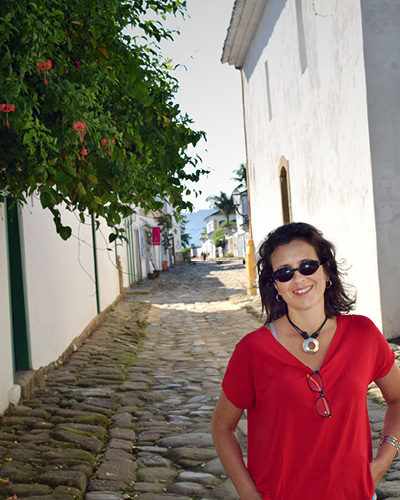 ack at photos of that time now, I can see the swelling in my body, particularly my face, caused by the medication, but I did not let this prevent me from travelling.
ack at photos of that time now, I can see the swelling in my body, particularly my face, caused by the medication, but I did not let this prevent me from travelling.
Crohn’s diagnosis
I started working when I was very young, as my family had very limited resources. I took a job as an export representative, as I hoped a career in foreign trade would let me travel to exciting new places. When I was 19 years old, a couple of years after starting to work, I was diagnosed with Crohn’s disease. It was a very scary time, because I was very ill, and it took the doctors a long time to diagnose my problem. I was afraid of many things, including not being able to make my dreams of travelling into a reality.
‘foreign trade would let me travel’
Unfortunately, many of the things I was afraid of came true: over the next years I had many complications. My disease trajectory was like a dictionary of Crohn’s-related problems: there were flare ups, fatigue and fistulas, as well as multiple abscesses, anaemia, stenosis, bleeding and body bloating from the cortisone. It was a very difficult time, with endless visits to the hospital and expensive treatments. Travelling became just a dream, as I spent many days in bed at home or in the hospital. I spent the next 25 years in and out of hospital, with intermittent periods when I was well.
Travel and love
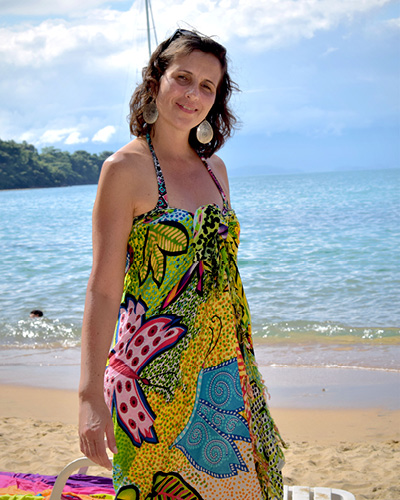 Every time I felt well enough, I would take the opportunity to travel within Brazil, and, whenever there was a possibility, I would take a business trip abroad. It was during my first international business trip that I met my husband; it was love at first sight (more of this in a future story), and, soon after, I left my home country and job to start a whole new adventure. I knew that Crohn’s could show its ugly face at any time, but I was willing to take the risk and pursue the love of my life and my love for travelling.
Every time I felt well enough, I would take the opportunity to travel within Brazil, and, whenever there was a possibility, I would take a business trip abroad. It was during my first international business trip that I met my husband; it was love at first sight (more of this in a future story), and, soon after, I left my home country and job to start a whole new adventure. I knew that Crohn’s could show its ugly face at any time, but I was willing to take the risk and pursue the love of my life and my love for travelling.
In 2003, there was the next big adventure: moving to London with the man who was to be my husband. Our first time living as a couple was complicated by the ups and downs of Crohn’s disease. But we travelled a lot during this period and made wonderful memories.
‘Museum toilets became firm favourites’
We both also remember, wherever we went, the feeling of desperation trying to urgently access toilets. London was great for this. Museum toilets became firm favourites, especially those at the National Gallery, as well as those in the fancy hotels. I developed strategies for getting past security in the best hotels in central London—the toilets at the Ritz are the best. But there were other times when any old dirty toilet would do, if it was an emergency.
Facing up to surgery
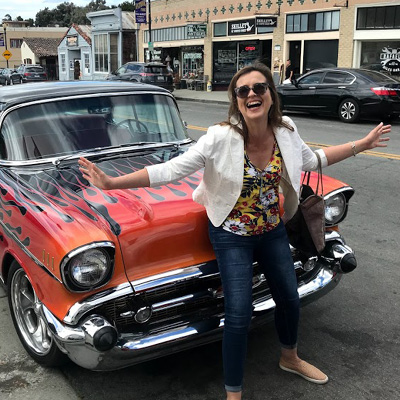 Years passed with ups and downs, but the disease was getting steadily worse. My doctor kept trying everything possible to avoid surgery, but in 2015 we started discussing the possibility. It was the risk of cancer caused by constant inflammation from Crohn’s that made me finally, in May 2016, start discussing the details of the first surgery. In September I had the first procedure. I woke up to learn that, due to complications from Crohn’s and the high risk of cancer, I was not only missing my rectum, but my anus as well. It was a great shock to realise that I had become a permanent ostomate.
Years passed with ups and downs, but the disease was getting steadily worse. My doctor kept trying everything possible to avoid surgery, but in 2015 we started discussing the possibility. It was the risk of cancer caused by constant inflammation from Crohn’s that made me finally, in May 2016, start discussing the details of the first surgery. In September I had the first procedure. I woke up to learn that, due to complications from Crohn’s and the high risk of cancer, I was not only missing my rectum, but my anus as well. It was a great shock to realise that I had become a permanent ostomate.
However, I did not have time to get depressed, as this surgery was only the start of what eventually became five surgeries over a period of 8 months. I had to spend endless days in the hospital, living a day at a time, thinking I would never be able to do the things that I used to. But I was wrong; slowly my desire to live and chase dreams came back, and so did my hunger for travel.
Resuming life
Only 6 months after my third surgery, we went for a 7-day road trip to Rio State, where we spent most of the time at the beach. Swimming in the sea, surrounded by colourful fish, was certainly not something I imagined that I would do again. All my fears disappeared at that moment, and I knew that life would not just carry on, but that it would improve, so long as I accepted the conditions and challenges of my changed situation.
Continuing adventures
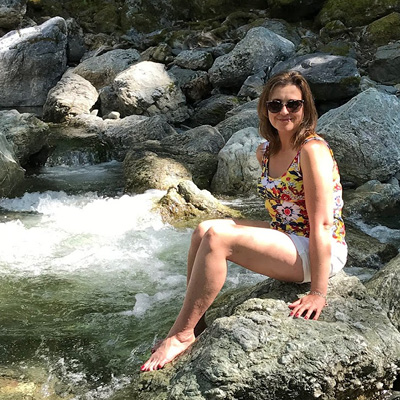 Since my last surgery, I have had the fortune to travel a great deal, and we even spent a year living in California. My first international flight since becoming an ostomate was certainly very scary, as I was facing 18 hours travelling, including connection times. I was terrified of the idea of flying with an ostomy pouch, as I had read many stories about people having difficulties with the bag filling up with the change of pressure. I prepared all I could think of for this trip. But, in the end. it went smoothly; there were no issues, no filling up of the bag, really nothing to worry about.
Since my last surgery, I have had the fortune to travel a great deal, and we even spent a year living in California. My first international flight since becoming an ostomate was certainly very scary, as I was facing 18 hours travelling, including connection times. I was terrified of the idea of flying with an ostomy pouch, as I had read many stories about people having difficulties with the bag filling up with the change of pressure. I prepared all I could think of for this trip. But, in the end. it went smoothly; there were no issues, no filling up of the bag, really nothing to worry about.
‘All my fears disappeared’
One of my most memorable adventures was going to the Grand Canyon last November. Words are not enough to describe its magnificence; this place definitely merits its status as one of the world’s seven natural wonders. I overcame my own limits: we did a 6-mile round hike, and it took us about 6 hours to go up and down. When we started out, I told myself: ‘down is optional, but up is mandatory’. For me, it was more than going on a hike; I really tested my limits, and I made it. My husband and my sons were also very proud of me.
I have plans to come back one day and hike all the way to the bottom, where the Colorado river flows, which is 18 miles round. From November to December we made several road trips: Las Vegas, Los Angeles, San Diego, Like Tahoe, and we are making plans for future travels before moving back to the UK.
Hiking and climbing
Honestly, I do so much more now than in the past. I now divide my life int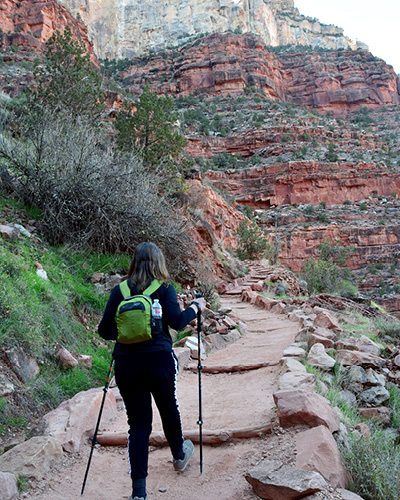 o the part before and after getting the ostomy. Despite having a parastomal hernia that sometimes can be really painful, I go on hikes and climb mountains. I am not an athlete, but going on trails and hiking have always been hobbies.
o the part before and after getting the ostomy. Despite having a parastomal hernia that sometimes can be really painful, I go on hikes and climb mountains. I am not an athlete, but going on trails and hiking have always been hobbies.
‘My first international flight was scary’
Hiking again after ostomy made me overcome my obstacles and helped me gain my confidence back and do what I want. When going on hikes, I make sure to always wear a hernia belt to protect it. I don’t have any plans to address the hernia further, as I have already had two hernia-repair surgeries and both failed.
Preparing for travel
In the end, travel need not be a big issue for an ostomate. But we must keep in mind, as in all other situations, that we need to be organised, adapting our normal routine and preparing for how to deal with any possible accidents.
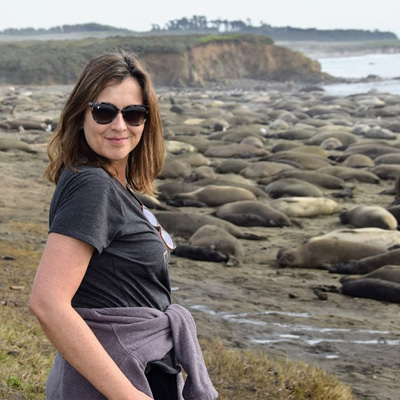 Now, whenever I travel, I go through a routine a few days before, where I prepare my ostomy pouches by pre-cutting the flanges and setting aside several additional pouches to put in my carry-on luggage. I also make sure to pack sufficient hygiene materials, such as baby wipes, gauze pads, no-rinse skin cleanser and disposal bags. Always have a backup kit; I got used to taking repeat kits in my carry-on as well as my checked-in bags in case one is lost. Having my kit within easy reach make me feel more confident about travelling.
Now, whenever I travel, I go through a routine a few days before, where I prepare my ostomy pouches by pre-cutting the flanges and setting aside several additional pouches to put in my carry-on luggage. I also make sure to pack sufficient hygiene materials, such as baby wipes, gauze pads, no-rinse skin cleanser and disposal bags. Always have a backup kit; I got used to taking repeat kits in my carry-on as well as my checked-in bags in case one is lost. Having my kit within easy reach make me feel more confident about travelling.
For me, since the surgery, it has also become important to use compression tights to avoid swelling and reduce the danger of thrombosis, which they do well. Another way to make a long trip easier is to watch what you eat. You know your body’s responses, so plan ahead and do not eat foods that you know will give you wind or irregular output.
‘travel need not be a big issue’
Don’t let your ostomy prevent you from doing things you have a passion for. Whenever you travel, plan your trip, organise your ostomy products and always bring extra material. Don’t be ashamed to say to a customs officer that you have special needs; long journeys can be very tiring. As I have a parastomal hernia, I always ask for help, and I don’t carry anything heavy.
If you are traveling abroad, split part of your ostomy products in different suitcases, in case one gets lost. It is also a good idea to bring some ostomy products in your handbag. Have your flanges cut and make sure to carry some baby wipes; they are very useful. Baby wipes are the easiest way to clean your bag, and whenever I go hiking I always bring them in my backpack, along with a pair of gloves, in case there is no water available to wash my hands.
Further travel reading
Follow the adventures of fellow ostomates:
• Helen Bracey on her travels to New Zealand and Central America
• Rachel Jury on her first flight since getting two stomas
• Evelyn Wood on his trek through Kyrgyzstan
• Laura and Mike on their trip through 17 countries
No stopping
Life is like a train, stopping at stations of joy and sorrow, fears and fantasies, hellos and goodbyes. Having a chronic illness, we never know when it’s time to step down from the train and we never know where the train will take us. The best thing to do is to try having the best journey we can!
 Luciana Podschun lives with her husband and their two boys, and she enjoys nature, travelling and gastronomy
Luciana Podschun lives with her husband and their two boys, and she enjoys nature, travelling and gastronomy
The contents of this page are property of MA Healthcare and should not be reused without permission

